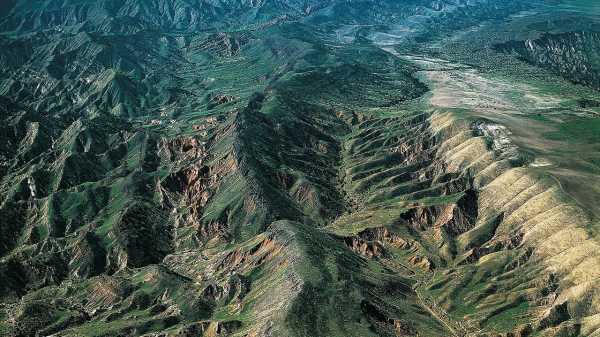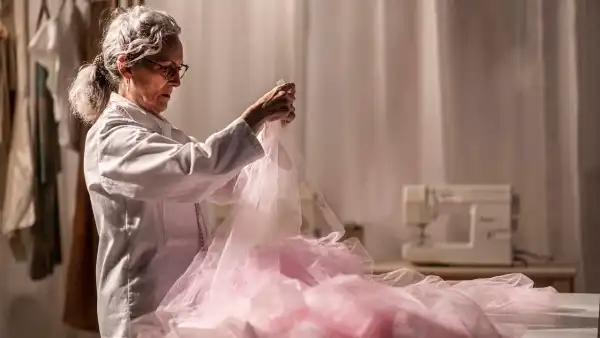
An appealing theme of Dan Taberski’s recent podcast “Headlong: Surviving Y2K” was the value of planning for possible calamity. Anticipating wide-scale chaos—like what might have befallen the world if most of its computers went berserk—made people in 1999 go a little nuts, but it also helped people plan, technologically and otherwise, and thus feel somewhat reassured in the run-up to the moment. It also helped people survive. A couple of survivalists who ran a wilderness school outside San Diego seemed deeply eccentric, even paranoid, for most of the series—sleeping outdoors for a decade, digging crawl spaces, tanning hides—until the wildfires of 2003 came. Because of their preparedness, they made it through; twelve of their neighbors didn’t.
“The Big One,” a podcast that débuted yesterday from the Southern California NPR station KPCC, is riveting for similar reasons. It reminds us of a fact that we enjoy not thinking about: that the San Andreas Fault, which runs nearly the length of California, is due for a giant shakeup. A devastating earthquake could come any minute—or not for another several decades. Whenever it is, Los Angeles could be hit hard. “The Big One” aims to prepare the listener by explaining the likely destruction that such an earthquake would cause, its ripple effects, and its science. It’s the stuff of nightmares. But—even though it inspires a strong urge to avoid living in California—it’s also strangely reassuring.
The podcast, produced by Misha Euceph, is hosted by the KPCC science reporter Jacob Margolis. As the series begins, he takes us through a you-are-there scenario. (A similar mode is found in “The Really Big One,” a piece, in this magazine, on the earthquake that could devastate the coastal Northwest.) Subtle music, suggesting anticipation, plays in the background. “Imagine you work in downtown L.A.—the heart of Los Angeles,” Margolis says. “Every morning, you wake up at your house in the suburbs, you walk to the train, and you make your way in. You’re headed to Union Station. You and a hundred thousand other people pass through here every day. Maybe you work in finance or in fashion.” This doesn’t sound like me, but O.K. “You say hey to the barista you’ve known for the past three years; you reach into your pocket for your wallet.” Not so fast, you and the barista—“There’s a monster beneath your feet, lying in wait,” and today, it strikes. A hundred and sixty miles away, in the desert, two massive tectonic plates slip against each other, sending a huge amount of energy through the earth. We hear the beginning of an earthquake—deep and ominous tremors—and it’s powerful listening. You imagine the underground plates and feel some tremors yourself. The seismologist Lucy Jones, a wise and down-to-earth expert who appears throughout the series, takes us through earthquake seismology, step by step. Margolis contextualizes and also keeps painting our narrative picture: the ground shakes harder and harder, you dive under a table, people fall to the ground; outside, car alarms go off. Then our scenario begins to rub me the wrong way. “You try to call your wife. And try again,” Margolis says. (I don’t want a wife!) “Panicked, you text, ‘Are you home? Are you O.K.?’ ” He puts some emotion into this delivery, which begins to feel manipulative—we don’t need to be coached to be scared here. “You can’t get ahold of your mom and dad, your sister, anyone you love.” O.K., O.K. “The shaking starts again.”
In the first few episodes, “The Big One” maintains this balance—mostly fascinating listening, full of illuminating science, history, and context, with occasional off notes. The strong parts dominate. We hear first-person accounts of the Northridge earthquake of 1994—not a big one—in which, we learn, a hundred thousand people were suddenly without homes, and bricks and glass rained down. (A doctor says that removing glass from feet was his most common post-earthquake request.) The third episode dives hard into the science; one charming story involves a junior at U.C. Riverside freaking out over seeing Charles Richter, of Richter-scale fame, at a 1970 local meeting of the Geological Society of America. The production consistently makes effective use of sound. Early on, just as I was noting to myself how much I was enjoying the show’s spare, satisfying use of stringed instruments—light tapping and humming, evocative of vibes in the earth—it suddenly made the instruments active characters, comparing “bows dragged against strings” to the shifting of tectonic plates, and indicating various earthquake magnitudes by playing a series of deepening, loudening double-bass notes. A little “Peter and the Wolf”-ish for a podcast, perhaps, but I loved it.
The off notes, to me, are of two kinds. First, that occasional mild flirtation with scaring us, or being a little dramatic. (Or disgusting us, via imaginings of raw sewage and the like, sometimes in podcast-speak: “Shit’s? Streaming out.”) But with this subject the line between terror and education is thin; shocking us repeatedly is mostly legitimate and helps us understand. The show’s other off note is its point of view, which seems to presume an audience of educated, financially comfortable listeners: homeowners living in the suburbs, working in finance or fashion, saying hey to the barista. A conversation in Episode 2 between Margolis and his wife about their big-one worries has a similar tenor: they talk about possibly getting stranded during the workday, far from their nanny and son. In the fourth episode, Margolis and another reporter visit Unincorporated Palmdale, a neighborhood in a liquefaction zone, above the fault—a very dangerous place to be during an earthquake. The other reporter asks a man named Tyrone Jordan, “When you were choosing a home, was it kind of, like, ‘You gotta live somewhere?’ ” “Not at all,” Jordan says—he loves his neighborhood and his spacious house with a view of a lake. With obvious enthusiasm, he recalls the day he discovered it. You could ask much of the population of California, including people in fire-hazard zones, if they just gotta live somewhere—as well as many people all over the world. Later in that episode, you, the married homeowner, get a neighbor friend, Elle, who rents a town house, now inhabitable, which she lives in with her kids. She hasn’t heard from her landlord and has to leave town. I’m glad that the producers included a rental scenario, though I’m less glad that you seem to be better situated than your neighbor. I hope that later episodes continue to broaden in scope and respectfully acknowledge that you might be any kind of Californian.
Generally, “The Big One” effectively and engagingly helps us think about the unthinkable. Beyond possibly inspiring sales of nonperishable foods, bottled water, flashlights, batteries, radios, and sturdy tables, it provides listeners with something of ineffable value: an idea of what wide-scale devastation might look like and how, practically and psychologically, one might survive it. (I’m assuming that “you” will survive.) And, perhaps above all, it inspires gratitude for every day that the big one doesn’t come.
Sourse: newyorker.com






